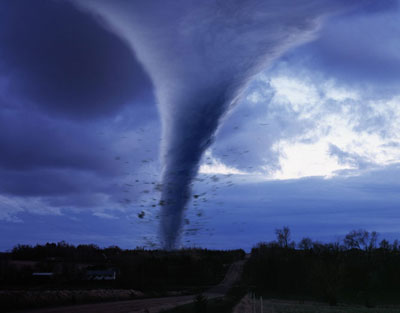Crazy Weather Stories: Tornado Edition

It's a Twister!
As with all crazy weather, Tornado's are scary. They are unpredictable and deadly. They cause millions of dollars of damage and they can literally destroy a town in a matter of minutes. So what causes Tornado's? Can they be predicted? And how do you protect yourself from one? These are all questions I will answer in this article so we can all be better prepared should we ever encounter a "twister".
At it's most basic, a Tornado is a violently rotating column of air that is attached to a cloud and touches down upon the Earth. They type of cloud a Tornado forms from can vary, but typically they are formed from Cumulonimbus clouds, a dense, towering vertical cloud that is often associated with Thunderstorms and any other types of unsettled atmospheric instability. Typically Tornadoes are in the shape of a funnel, but they can come in all shapes and sizes and can form over water (know as Waterspouts) or in the middle of a desert without any storm clouds visible. We are going to focus here on the Tornado's that are seen primarily in the mid-west sections of the country known as "Tornado Alley", which focuses mainly on Texas, Oklahoma, Kansas and Nebraska.
Why?
So, what makes a Tornado? According to www.why.org, there are a few factors into what bring a Tornado to life:
- A very strong jet stream, which provides the necessary vertical wind shear — an increase of wind speed with height. This wind shear is what starts the funnel rotating.
- A substantial amount of water vapor, especially in the lower troposphere. When this moisture condenses, it releases most of the energy that drives the storm — acting rather like a steam engine.
- Warm, dry air at middle altitudes. In Tornado Alley, this air comes off the Mexican plateau and puts a lid on the warm, moist air building in the lower atmosphere. In the Southern plains, solar energy almost literally cooks the water vapor, but the cap prevents gradual release of this energy. Then, suddenly, an explosive thunderstorm occurs out of the blue sky and starts to release this energy, which is the source of power for the convective storms that create thunder, lightning and tornadoes.

Detection & Ratings
There is a lot of effort going on to study and learn how and when Tornado's form so as to give people time to seek shelter. Before the 1950s, the only way to warn of a Tornado was to actually see it on the ground, thus not giving people much time to get themselves and their families to safety. With the advent of weather radar, it was made much easier to detect and therefore, warn, people of the incoming weather system.
The first public Tornado warnings were issued in 1950 and Tornado watches began in 1952. The study of Tornado's and what caused them helped meteorologists to home in on their radar screens and more accurately predict when and where a Tornado would hit.
Tornado's are rated on a scale of 1-5, the scale is called the Fujita Scale and it rates Tornado's on the amount of damage caused, 1 being a mild Tornado and 5 is the worst. In recent years an Enhanced Fujita Scale has been created and while the Tornado's are ranked the same way, it is identified by using the EF letters before the number, so EF5 would be the worst Tornado.
History.
In history, there have been many deadly Tornado's but the worst was by far the Daultipur-Salturia Tornado in Bangladesh (Tornado's are often named for the regions they hit) on April 26, 1989 which killed 1,300 people. The Tri-State Tornado, which made it's way through Missouri, Illinois and Indiana on March 18, 1925. Meterologists say that it was most like an EF5 Tornado but since such ratings didn't exist at that time, it is hard to say for sure. The Tri-State Tornado holds a few records for longest duration (3.5 hours), longest path length (219 miles/352km) and fastest forward speed for a large tornado (73mph/117km/h). In addition, it was the most deadly Tornado in United States History, killing 695 people. And finally, in April 2011, in the span of about 4 days, there was a record breaking 355 Tornado's, 211 of them occurred in one 24 hour period.
It is almost impossible to accurately measure the true wind speeds of violent tornado's, as today's equipment would be destroyed in the violent storms so Meterologists rely on scans of Doppler Radar units, which give fairly accurate readings. The highest wind speed every recored for a Tornado (or recored on the PLANET) is about 301 mph in an EF5 Tornado that effected the Oklahoma region and killed 36 people.
In addition to the violent winds, there is debris flying everywhere as a Tornado cuts a swath of destruction across the Earth. Due to severe updrafts, the Tornado sucks up houses, cars, animals, etc and tosses it out of the funnel. Debris can fly up to 150 miles out from a Tornado, meaning that even if you are fairly far away, you are still in danger from the twister.

Destruction & Having a Safety Plan
Tornado's can level a town, as they did in recent years in various parts of Missouri and Oklahoma. The death toll in Joplin, MO after a May 2011 Tornado was as high as 122 people. Also in that year, in April, Tornado's in Alabama and other nearby states killed 314 people, which is the 4th highest death toll in U.S. Tornado History. In 2013, an EF5 struck Moore, OK and killed about 24 people, injured over 300 and caused around $2 billion in damages, almost totally leveling the town.
Tornado's are a destructive, deadly force of nature that is not to be trifled with. If you live in a Tornado prone area, it is best to have a plan of evacuation and safety for you and your entire family.
On the Red Cross website, they list precautions to take as well as to know the difference between a Tornado Watch (where Tornado's are possible) and a Tornado Warning (Tornado's have been spotted & seek shelter). It is vital to keep an eye on the local weather stations so that you know if a Watch or Warning has been issued. Here are some more safety tips courtesy of the Red Cross. Make sure to check out their site for even more tips.
- Be aware of the local weather, if you notice changes that could spawn a Tornado, tune into the news right away or go to NOAA to view if any advisories, warnings or watches are in place.
- The safest place is an underground shelter such as a basement or cellar.
- If you do not have underground shelter than a small, windowless room or a hallway in the interior of the house, on the lowest level, is a good alternative.
- Prepare a Tornado evacuation plan with your loved ones before a storm strikes, have supplies, a place of shelter and/or a route to a sturdy shelter available to you. Practice this drill often.
- Make sure to clean up your yard of any potential debris from toys, trees or furniture if a watch is in place.
- Go to www.redcross.org for more information and safety tips.
The Birth of a Tornado - AMAZING Video.
Be Prepared!
In the case of any extreme weather it is vital to have a plan in place should tragedy strike. It is always a good idea to have a First Aid Kit (updated yearly) along with Fire Extinguishers (checked yearly) and other safety items (blankets, shovels, etc) easily available. Communication with loved ones is also a key factor, make sure everyone in your household knows the plan and where to meet should you be separated.
In the end, any extreme weather is unpredictable and scary but the most important thing is keeping those you love alive and healthy. Any damage or destruction can be fixed or replaced, humans and pets cannot be.








